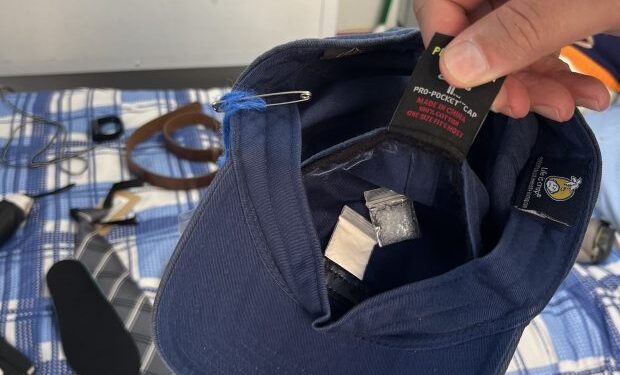The bedroom display at Lincoln-Way West High School is typical of most teenager’s rooms with personal belongings strewn across the bed and on the shelves.
But a closer look reveals potentially dangerous, if not deadly, items disguised as common belongings.
Teenagers engaging in substance use can find ways to hide drugs and drug paraphernalia. The Heroin Epidemic Relief Organization and the Will County sheriff’s department presented their Hidden in Plain Sight trailers featuring a mock teenage bedroom to help educate parents on the latest trends in teenage substance use.
A tennis ball or teddy bear is slit open to conceal drugs. A ball cap has a secret compartment. A nondescript water bottle or pop can is actually a safe. A girl’s hair tie has a zipper to hide valuables. A set of emojis are codes for drugs or drug dealers.
The Hidden in Plain Sight trailers were among the comprehensive resources at the Your Light Still Shines event Wednesday at Lincoln-Way West, designed to provide the community the resources and education they need for loved ones who may abuse substances. The event, sponsored by the village of New Lenox and its Safe Community Coalition, coincides with International Overdose Awareness Day.
“The more you know, the better off you are,” said Tim Ignowski, a volunteer with the Heroin Epidemic Relief Organization. “We want to bring awareness to parents. A lot of this stuff is in bird’s eye view.”
Ignowski, who has been sober for nearly two years, volunteers so he can stay centered, he said. Parents should know their loved ones can take many common substances, such as flower seeds that produce hallucinogenic effects or over-the-counter medications to get high. Items used to hide personal belongings when people travel, stay in hotels, go to concerts or go to the beach are also used to stash drugs and can easily be bought on Amazon or in smoke shops, he said.
Parents who see their children’s behavior change, whether thy come home with bloodshot eyes or fall asleep at dinner, should check their kids’ rooms for any telltale signs they might be using substances, said Jason Moss, a board member with the relief organization. Parents should talk with their children, monitor their friends and see where their money is going, he said.
Like Ignowski, Moss, a former addict who has been sober for more than six years, wants to give back.

The Hidden in Plain Sight trailers change with new trends and travel to events to train adults what to look for in their homes.
Moss said they know they won’t eliminate the drug problem, but it could help a child, a family member or neighbor.
With technology, teens can easily search the internet for drugs, learn about them via TikTok and social media, and order items online, making access to substances so much different than a generation ago, said Kathleen Zacharias with the sheriff’s office Substance Abuse Prevention Coalition Community Care Team. The organization is featured at back-to-school events, carnivals, car shows, churches and block parties to help reduce substance abuse.

“It starts with education,” Zacharias said. “We need to openly communicate with our youth. … When you openly communicate with your child and they come to you about the glamorization (of drugs), you give them the realization. Addiction doesn’t discriminate. It doesn’t matter your gender, your nationality, your sexuality.”
At Wednesday’s event, the sheriff’s office collected unwanted medication for proper disposal. Over-the-counter or prescription medicine that is unsecured can cause medication misuse, organizers said. Opioid-based pain killers can also fall into the hands of teens and lead to addiction.
More than 30 resource organizations that specialize in in substance use disorders, treatment, counseling and prevention set up booths.
A memorial area was set up for families to display a loved one who lost their fight with addiction.

Krystal Ruggiero placed two framed photos of friends who died from an overdose. She attended with her 15-year-old son to help educate him on the dangers of fentanyl, listen to the speakers and view the memorial. Assemblies similar to Wednesday’s should start in seventh grade, she said.
Dennis Karr, director of operations for the Existential Counselors Society, an inpatient rehabilitation center in Joliet, brought 13 men in recovery to the event to see the support Will County has to offer.
“Most have been impressed with the resources offered in Will County and the surrounding area,” said Karr, who has been sober for six years. “It brought enlightenment that so many people are willing to help. They are only with us 28 days. Upon discharge, there are resources that will see to it they will succeed to become independent, respectable men, husbands and fathers.”
The community could also take home naloxone, a medication used to reverse the effects of an overdose.
Will County gave out more than 11,000 boxes of naloxone in 2023 and has given out more than 8,000 boxes so far this year, said Connie Dewall, program manager with the Will County substance use initiatives in the county’s health department.
“We are trying to break the stigma,” Dewall said. “You are human. You deserve the right to live. Everyone deserves a chance.”
Naloxone can be found throughout the county, such as in food pantries and the Will County Health Department. Officials also try to place the life-saving medication in businesses in areas known to have high drug trafficking.
Dewall said the county’s efforts to distribute naloxone have helped, noting there was a 22% to 23% increase in both the Hispanic and Black communities who are requesting it.
According to Will County statistics, there were 141 drug-related deaths in 2023, including 95 deaths due to heroin or fentanyl.

This year, there were 53 drug-related deaths, including 36 deaths due to heroin and fentanyl. The drug-related deaths, which was updated last week, includes residents from several communities countywide ranging in age from 19 to 70, data shows.
John Roberts, co-founder and president of the Heroin Epidemic Relief Organization, lost his son Billy, 19, to an overdose in 2009. That year, there were about 28,000 drug-related deaths across the country, Roberts said.
Last year, there were nearly 108,000 drug overdose deaths in the U.S., a decrease of 3% from 2022 and the first annual decrease in drug overdose deaths since 2018, according to the Centers For Disease Control and Prevention.
“I thought it was the hidden epidemic,” Roberts said. “It is actually the ignored epidemic. We are still ignoring it.”
Roberts said if the community does nothing, the problem will continue to spread, which is why awareness events and distributing naloxone are so important. Events, such as Your Light Still Shines weren’t available 15 years ago when his son died, Roberts said, noting when he asked a hospital for resources, the list they provided included services that were out of business.
New drugs will continue to be introduced to the community, he said.
“Until people come together and say we are not going to put up with this problem ever again, anymore, this problem will continue,” he said.
Daniel Martin, the Safe Community Coordinator for New Lenox, said he wanted community members to leave feeling hopeful.

Jim Scarpace, the community division president and chief clinical officer for the Gateway Foundation, said about 80% of clients with a substance use disorder have a mental health disorder such as depression, anxiety or trauma that needs to be treated at the same time.
Many clients have experienced childhood physical or emotional abuse or neglect, sexual abuse or some type of household dysfunction such as a mother who was abused or a relative who was incarcerated. There’s a lot that needs to be done help people understand the relationship between trauma, which can alter the brain’s function, and substance use, he said.
“This is a physiological disease. This is a psychological disease, and this is a social disease,” he said. “It affects our loved ones. It affects their brain. It affects their body and it affects their behaviors. What’s most important is that it’s not who they are, and like any other medical condition, it can be treated.”
Like other illnesses, relapses can occur and treatment never follows a straight path, Scarpace said.
“Our goal as treatment providers is to inspire people to change, for them to find internal value in themselves, to see themselves for more than just their substance use disorder because that’s not who they are,” he said. “Every single one of us can change a person’s life.”
Michelle Mullins is a freelance reporter for the Daily Southtown.







